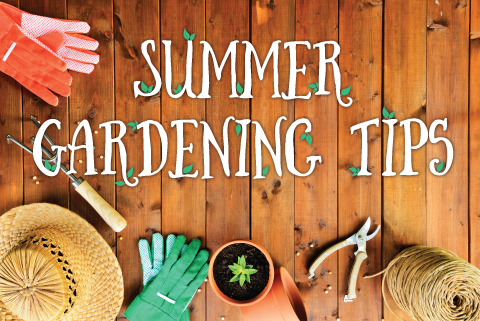
Summer Gardening Tips
From the Northwest Campus Horticulture Program
Special thanks to Crystal Smith, adjunct instructor of horticulture.
Hose vs. Nozzle Watering
Using a hose to water has been cited by the Environmental Protection Agency (EPA) as the least wasteful way to water, but it is not practical for larger yards. The most efficient way will be to use a soaker hose and drip line. Unfortunately, a soaker hose and drip line are not always practical for the largest part of most home gardens, the turf. A finely tuned, in-ground sprinkler system is the most efficient way to water turf. In these systems, the timer can be set to water when there is less chance of loss due to wind and sun. Many systems have sensors that prevent the sprinkler from turning on when it is raining or freezing. Several cities offer free sprinkler checks to help homeowners minimize water usage.
Focus on the Roots
Water is best applied to the roots. Water on foliage can encourage disease and pests and when sprayed on some flowers can cause them to spot.
Mulching Flowerbeds
Perennial beds should be mulched. At a depth of two to four inches, there are many advantages. It improves the overall look of the garden bed, discourages pests and prevents water loss from the soil.
Watering the Lawn
The amount of water needed depends on the type of grass. In general, you want to water to a depth of six to 12 inches once or twice per week (less if it rains). You can use a wide-mouthed, flat-bottomed can with straight sides to measure this. Set several cans in the area you are irrigating and set a timer to determine how long you need to water to reach the desired amount.
Watering Perennials & Shrubs
In general, you should wait until the soil is dry (dig down four inches to test this). Shrubs need 12 to 24 inches of water and trees need 18 to 36 inches, once or twice per week. Some plants, such as azaleas, may require more.
Watering Amount vs. Frequency
The most efficient way to water plants is to water at intervals within the same time period. For instance, you have a sprinkler system and determine that it takes 15 minutes to reach the 12-inch depth that you are trying to achieve. You also notice that after five minutes, water starts to flow heavily off of your lawn, down the sidewalk and into the street. In this case, you should alternate watering for five minutes, and wait for 10 or so minutes until you reach the 15 minutes of watering. This allows water to sink into the soil where it will benefit the plants.
Best Time to Water
Early morning is best (4 a.m. to 9:30 a.m.) Watering in the evening encourages insects and disease.
Over & Under Watering
A plant that is dry may have wilted, or sometimes, leaves that look gray. Some plants are sensitive and will have wilted leaves in the heat of midday sun even with adequate amounts of water. The leaves of these plants will return back to normal once the sun goes down and temps cool off. While using wilting leaves as a good rule of thumb is fine, it should be understood that it is not foolproof. Plant roots are damaged whether you over or under water, which results in these same symptoms. This makes it difficult to use leaves as a gauge for whether or not you are applying the right amount of water. Instead, check the soil. Soil that is overly wet will feel waterlogged, look grayish in color and sometimes has a rotting smell.
Cost-Effective Gardening
The best thing is to select plants that can thrive with less water (i.e. natives and drought-tolerant species). You can also build up the soil. Compost is a great way to amend soil as it adds fertility and improves soil structure. Most importantly, have realistic expectations. If you want a perfect garden at all times, then fill it with plastic plants!
